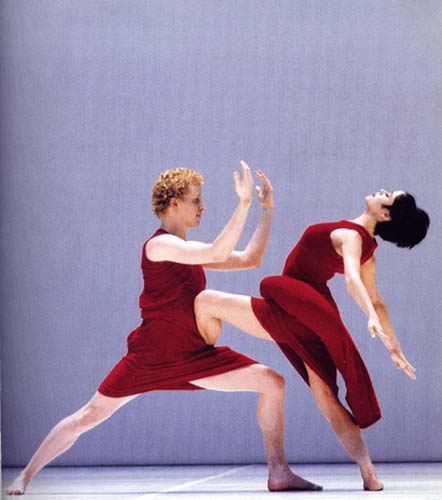Merce Cunningham and Fashion
/Merce Cunningham wearing a bulging Kawakubo's costume. Poster for Scenario, 1997. Photo: Thimoty Greenfield-Sanders.
Merce Cunnigham, who died July 27 at the age of ninety, had an unreputably lasting influence on the development of dance in the 20th century. In addition to his numerous collaborations with a number of visual artists, starting with Robert Rauschenberg, and musicians from John Cage, his life-partner, to Thurston Moore of Sonic Youth, he collaborated with the avant-garde fashion designer Rei Kawakubo. This was prompted by the Japanese designer's Spring/Summer 1997 collection “Dress Meets Body, Body Meets Dress and They Are One,” which created a range of unorthodox body shapes by including padding at the hips, back and belly.
The dance borne of the collaboration is titled Scenario, and premiered in October 1997 at the Brooklyn Academy of Music, where the dancers’ movements took place against a stark all-white stage, lit with fluorescent lighting to the contemplative repetitive music of Takehisa Kosugi and Thurston Moore. Scenario is roughly made of three movements punctuated by the change of the pattern and colour of the outer garments from gingham and striped blue and green, to all black and finally all red—while the padding understructure remains the same throughout. The way Kawakubo’s garments became activated by the dancers’ bodies in motion allowed for the creation of novel and unexpected bodily formations—which reinforced Cunnigham's exploration of the limits and scope of bodily movements, as well as enhancing the bulges and “distortions” of Kawakubo’s 1997 collection.
Scenario, BAM, 1997
Much like Cunningham's entire oeuvre, Scenario leads into uncharted formations and articulations of body shapes, this time highlighted by Kawakubo’s costumes. The alteration of proportions, and of one’s relation to one’s body and to the body of the other dancers and the subsequent sense of estrangement it creates is summed up by dancers in Cunningham’s company, who described the experience as alternatively liberating and unsettling: “If I were to be asked about it as a dancer, I would say it was more of a liberation when I came onto this incredibly wide stage in the costume.” “It’s bizarre to roll on the floor. Or when you touch someone, you’re a foot away from them.” There is, in fact, an element of absurdist humour in Scenario. This is especially evident in the first movement of the piece where the dancers are wearing the costumes with oversized gingham and striped patterns, which are not altogether unlike the heavily patterned costumes characteristic of the Commedia dell’Arte—of Harlequin, in particular.
Humor had been previously explored through costumes in a much earlier piece by Cunningham: Antic Meet from 1958. For this piece, which contains parodic references to Martha Graham's dramatic style of dancing, Cunnigham knitted for himself a sweater with four arms and no neck hole, and in a faux climatic scene struggled to resurface from the sweater. (Footage of the scene can be found in Charles Atlas’ documentary Merce Cunningham: A Lifetime of Dance).
Francesca Granata
Scenario, BAM, 1997

















